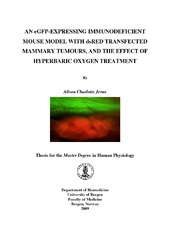| dc.description.abstract | Previous studies have shown significant anti-tumour effects of hyperbaric oxygen (HBO) treatment on chemically induced mammary tumours. Thus, to answer whether HBO has a general anti-tumour effect on mammary tumours, the study had three aims: 1. Establish two new mammary tumour models using eGFP (Green Fluorescent Protein) expressing immunodeficient mice and dsRed transfected tumour cells (4T1 and MCF7). 2. Elucidate possible effects of HBO treatment on tumour growth and angiogenesis. 3. Analyze the effect of HBO on the tumour interstitium. Methods: DsRed transfected cells were injected s.c. into the immunodeficient eGFP mice in the groin-area. All mice received oestrogen treatment prior to injection. After tumour development (~3mm) the mice were divided into three groups. One group was exposed to repeated HBO treatments (3 exposures), one to a single HBO treatment (both to 2.5 bar, 100% O2, à 90min) and controls to normal atmosphere (1 bar, 21% O2). Light microscopy, as well as multiphoton confocal microscopy, enabled investigation of the tumour-host interaction in situ. Treatment effects were determined by assessment of tumour growth (with calliper) and angiogenesis (CD31 staining). Moreover, tumour stromal factors such as Pif (with the wick-in-needle technique), collagen content (by hydroxyproline quantification) together with drug uptake ([3H]-5FU, using microdialysis) were measured. Results: Three million 4T1 dsRed cells injected in the eGFP mice induced tumours. The tumour cells invaded the stromal cells and a number of vascular elements were found in situ. Five million MCF7 cells injected in conjunction with matrigel did also induce tumours, although this model has to be further elucidated. In the 4T1 mammary model, tumour growth and angiogenesis were significantly reduced after repeated HBO treatment compared to control. However, no change in collagen density was found. A significant reduction in Pif was found in both HBO treated groups. Nevertheless, this did not affect the drug uptake. Conclusion: We have successfully established a dsRed transfected 4T1 mammary tumour in eGFP expressing mice. We also developed MCF7 human mammary tumours, although this model needs further refinement. The reduction in 4T1 tumour growth found after HBO treatment can, to some extent, be explained by the reduction in angiogenesis. The collagen density was unchanged after HBO treatment, possibly due to the short treatment period. A reduction in Pif was found after HBO treatment, thus without inducing enhanced drug uptake. The mechanisms behind these effects need to be further elucidated. | en_US |
